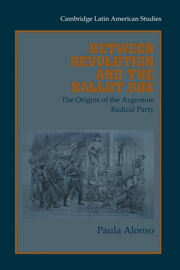Book contents
- Frontmatter
- Contents
- Acknowledgments
- List of Abbreviations
- List of Tables and Figures
- Introduction
- 1 The Political Arena
- 2 Mounting an Opposition
- 3 The Short-Lived Unión Cívica
- 4 The Radicals in Action: Part I
- 5 The Radicals in Action: Part II
- 6 The Decline of the Radical Party
- Conclusion
- Appendix 1 A Chronology of Political Parties and Factions, 1862–1910
- Appendix 2 Details of the Members of the National Committee of the UCR in 1892
- Appendix 3 Property Values in Buenos Aires, 1890–1898
- Bibliography
- Index
Introduction
Published online by Cambridge University Press: 05 August 2011
- Frontmatter
- Contents
- Acknowledgments
- List of Abbreviations
- List of Tables and Figures
- Introduction
- 1 The Political Arena
- 2 Mounting an Opposition
- 3 The Short-Lived Unión Cívica
- 4 The Radicals in Action: Part I
- 5 The Radicals in Action: Part II
- 6 The Decline of the Radical Party
- Conclusion
- Appendix 1 A Chronology of Political Parties and Factions, 1862–1910
- Appendix 2 Details of the Members of the National Committee of the UCR in 1892
- Appendix 3 Property Values in Buenos Aires, 1890–1898
- Bibliography
- Index
Summary
The Unión Cívica Radical (UCR), usually known as the Radical Party, is the oldest national political party in Argentina and one of two parties that have dominated Argentine politics during the twentieth century. Founded in 1891 to confront the Partido Autonomista Nacional (PAN), a coalition that had controlled Argentine politics since 1880, the UCR won its first presidential election in 1916, ending thirty-six years of continuous PAN political predominance. During its early years the Radical Party was led by Leandro Alem and fought the PAN with all methods available – words, votes, and guns – becoming the country's most destabilizing opposition force. After Alem's death in 1896, the party entered into rapid decline and by the turn of the century had disbanded. Hipólito Yrigoyen, Alem's nephew, began the reconstruction of the party in 1903, building on the ruins of the old political organization and winning the presidency in 1916.
This book focuses on the origins and development of the Radical Party at the end of the nineteenth century, from the party's foundation in 1891 until its decline at the end of the decade. Little is known about the formative years of the Radical Party. Traditionally, historians have divided turn-of-the-century Argentina into two periods: 1880 to 1916, when the country was under the restrictively democratic PAN regime; and 1916–1930, when the Radical Party came to power, inaugurating a democratic period under universal suffrage with secret and compulsory voting – an era put to an end by the first military coup the country experienced in the twentieth century.
- Type
- Chapter
- Information
- Between Revolution and the Ballot BoxThe Origins of the Argentine Radical Party in the 1890s, pp. 1 - 13Publisher: Cambridge University PressPrint publication year: 2000

